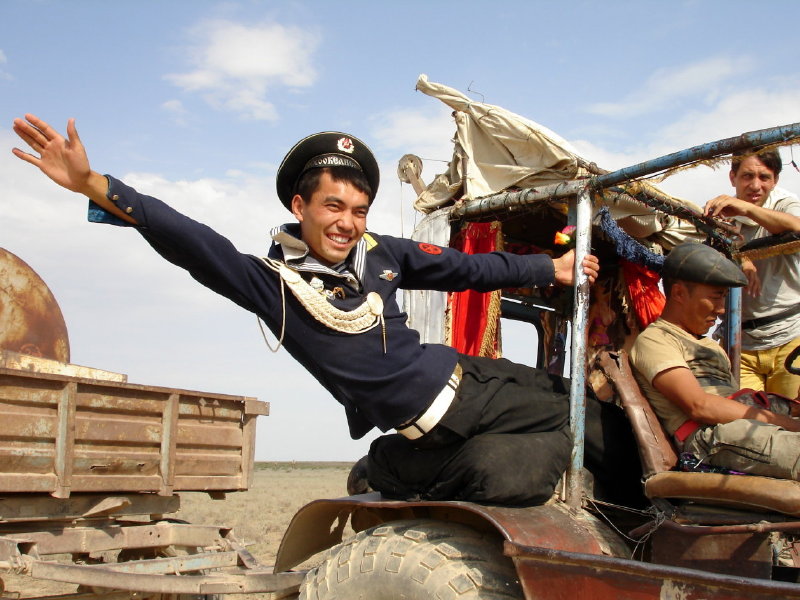Bayside resident Mark Metcalf is an actor who has worked in movies, TV and on the stage. He is best known for his work in "Animal House," "Buffy the Vampire Slayer" and "Seinfeld."
In addition to his work on screen, Metcalf is involved with Milwaukee Film, First Stage Children's Theater and a number of other projects, including comicwonder.com. He recently filmed an episode of the popular AMC series "Mad Men."
He also finds time to write about movies for OnMilwaukee.com. This week, Metcalf weighs in on a pair of 2008 movies -- "Tulpan" and "Tony Manero" -- that are screening this weekend at the UWM Union.
TULPAN and TONY MANERO
The main character in George Bernard Shaw's play "Misalliance" prefaces many of his lengthy speeches with something that, loosely paraphrased, sounds like, "There are two kinds of people in the world..." He then goes on to elaborate, as will I.
It seems that there are two kinds of movies in the world. One presents an imagined world against a backdrop of artifice -- either on a green screen, in miniature, with CGI effects of some magical sort, or in animation. Into this group, I would also place the typical Hollywood, or Bollywood-style romance that bears only the most fanciful relation to real interpersonal relationships.
Some of the spy or action movies that we see are also in this category, because even though they use documentary style camera work and struggle achingly for some sort of verisimilitude, they are more like a methamphetamine blast than the normal cup of coffee that most of us are used to. And when was the last time you heard about a high-speed chase in Manhattan lasting more than thirty seconds? They are fantasies, metaphors, or escapist literature.
The other kind of movie follows more closely Hamlet's dictum that the Players should "Hold the mirror up to nature." These films move sometimes alarmingly close to being documentaries. They usually have a cinematic style like a documentary. There is a strong feeling of improvisation amongst the actors. The structure is not always apparent and it sometimes feels as though the director has lost control of the story, if there is a story at all. When the film is good, you have the very strong feeling that you are eavesdropping on someone's life. That sometimes takes patience, because people's lives are not always all that interesting unless you are paying very close attention.
"Tulpan" and "Tony Manero", which will both be shown UWM's Union Theatre this weekend, fall into the latter category.
"Tulpan" is the first narrative feature of a Kazakh documentary filmmaker named Sergey Dvortsevoy. It takes place in an area of Kazakhstan called the Hungersteppe. It is literally tabletop flat for hundreds of kilometers. No brush, no grass, nothing grows above the height of your knee. It is flatter and more desolate than even big parts of North Dakota.
The people that live there are nomadic sheepherders usually not even owning their own flock, but managing a herd for a big-time owner who lives in the city 500 kilometers away. They live in small yurts, which are packed up and moved when the grass is gone or the seasons change.
It is a life as alien to what we know here as it can be, yet the people and what they are trying to accomplish is familiar. A young man, Asa, returns to his sister's family on the steppe after service in the Russian Navy.
We are introduced to him sitting cross-legged on the floor of a yurt telling a tale of the dangers of the giant octopus and other stories from his life at sea. The absolute incongruity of tales from the sea being told in this flat, dry, dusty landscape is very funny and touching. Asa is trying to impress a young woman, the Tulpan of the title and the only eligible female for several hundred kilometers, and gain her parents consent to marry her. We never see Tulpan throughout the film except as she peaks out from behind a curtain at Asa during his repeated attempts to woo her.
Asa's dream, and it is a fanciful dream for him, is to have a wife, several children, a flock of sheep of his own, and to live in a nice yurt, traveling across the steppe looking for grass. He is rejected at first, because his ears are too big, but the more he is told no, the firmer becomes his resolve.
The entire film was shot on location in the Hungersteppe. The cast lived in the yurt they shot in for a month before shooting, learning everything they could about the habits and the details of the life they represent.
There is one phenomenal scene when Asa has become fed up with the treatment he receives from Ondas and he grabs his bag and just walks off, walks away from the life he has dreamed of, but the only place to walk is into the wasteland which appears the same in every direction and for hundreds of kilometers.
As he charges off, he eventually calms down enough to look around and realize that he is even more in the middle of nowhere than he was before, but he comes upon a ewe who is trying unsuccessfully to give birth to her lamb. Drawn to the life, to the new life, he tries to help. But he has little or no experience with giving birth. The scene is shot in real time with a real sheep giving birth and the actor, who did not know that he was going to have to assist, manages to bring the lamb out and to give it life by blowing in it's mouth so that it can get the air it needs.
It is shocking and powerful and very moving by the end because you are caught in the struggle of the lamb for life, the mother to deliver, and with Asa, who is finding a bond with the land that he had not realized existed. And the camera never lets you get away, never comments, it just observes.
It is a wonderful movie and yet another chance to visit a part of the world that you won't find listed in any travel agency's brochure.
"Tony Manero" is the name of John Travolta's character in "Saturday Night Fever." The film is about a man who earns his meager living as a dancer but is trying to make it up and out of his existence by entering a John Travolta lookalike contest. He doesn't have a chance. In the opening scene, he is in line for the contest with a bunch of Chuck Norris lookalikes. He is a week early.
What makes the film important is that it takes place early in the Pinochet dictatorship in Chile. Raul, the man who would be Tony Manero, is a brutally violent man, living just beyond desperation, who will sacrifice anyone and anything to achieve the fantasy of being an American movie star.
The metaphor, or the parallels between Raul and Pinochet are obvious. Pinochet was a violently brutal dictator who was probably beholden to both the American C.I.A. and the American dream. In an early scene, Raul beats an old woman to death; a woman he has helped home after a gang of young boys robbed her. He beats her with his hands, smokes a cigarette then steals her television set.
It is the darkest of comedies and an artfully drawn allegory of the days past when American pop culture and American muscle held sway over much of the world. Did I say days past? That may have been wishful thinking.
Mark Metcalf is an actor and owner of Libby Montana restaurant in Mequon. Still active in Milwaukee theater, he's best known for his roles as Neidermeyer in "Animal House" and as The Maestro on "Seinfeld."
Originally from New Jersey, Metcalf now lives in Bayside.



